Consumer Profile Infographic
VerifiedAdded on 2023/04/20
|6
|812
|200
AI Summary
This infographic provides insights into the historical changes and consumer buying trends in the apparel industry of Europe. It discusses the key motivational factors, stimuli, perception, and exposure that influence consumer choices. It also explores the consumer knowledge schema and provides examples of successful marketing strategies used by companies like Zara.
Contribute Materials
Your contribution can guide someone’s learning journey. Share your
documents today.
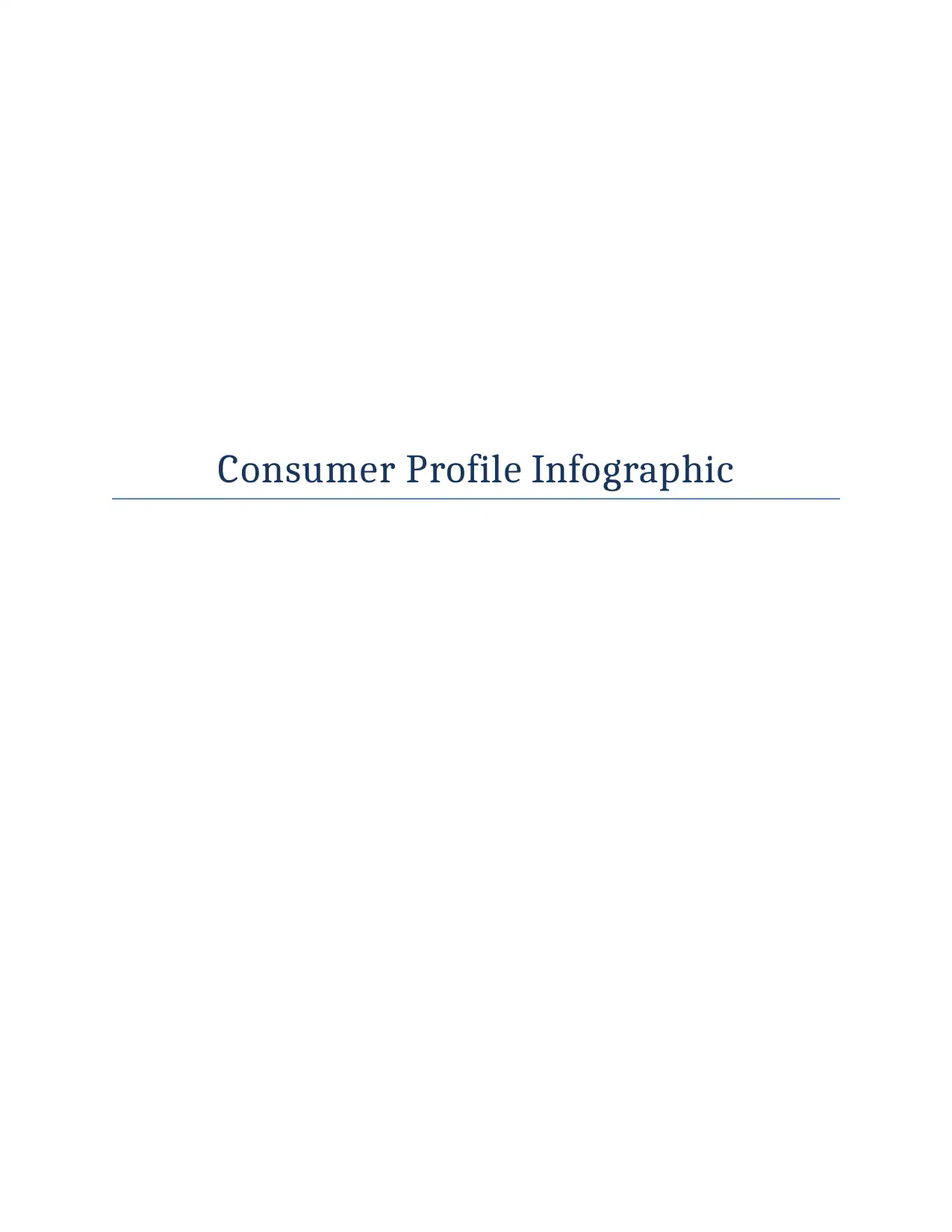
Consumer Profile Infographic
Secure Best Marks with AI Grader
Need help grading? Try our AI Grader for instant feedback on your assignments.
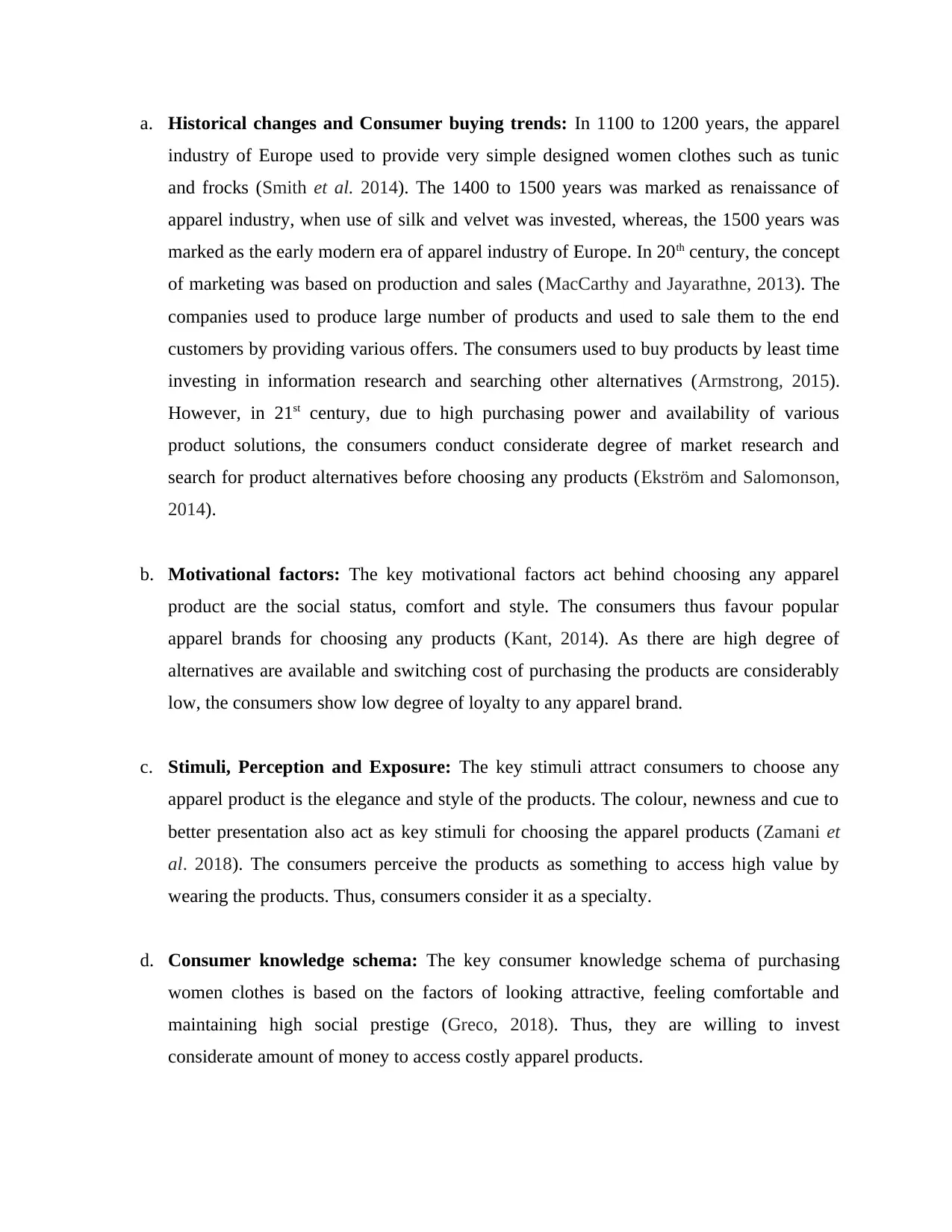
a. Historical changes and Consumer buying trends: In 1100 to 1200 years, the apparel
industry of Europe used to provide very simple designed women clothes such as tunic
and frocks (Smith et al. 2014). The 1400 to 1500 years was marked as renaissance of
apparel industry, when use of silk and velvet was invested, whereas, the 1500 years was
marked as the early modern era of apparel industry of Europe. In 20th century, the concept
of marketing was based on production and sales (MacCarthy and Jayarathne, 2013). The
companies used to produce large number of products and used to sale them to the end
customers by providing various offers. The consumers used to buy products by least time
investing in information research and searching other alternatives (Armstrong, 2015).
However, in 21st century, due to high purchasing power and availability of various
product solutions, the consumers conduct considerate degree of market research and
search for product alternatives before choosing any products (Ekström and Salomonson,
2014).
b. Motivational factors: The key motivational factors act behind choosing any apparel
product are the social status, comfort and style. The consumers thus favour popular
apparel brands for choosing any products (Kant, 2014). As there are high degree of
alternatives are available and switching cost of purchasing the products are considerably
low, the consumers show low degree of loyalty to any apparel brand.
c. Stimuli, Perception and Exposure: The key stimuli attract consumers to choose any
apparel product is the elegance and style of the products. The colour, newness and cue to
better presentation also act as key stimuli for choosing the apparel products (Zamani et
al. 2018). The consumers perceive the products as something to access high value by
wearing the products. Thus, consumers consider it as a specialty.
d. Consumer knowledge schema: The key consumer knowledge schema of purchasing
women clothes is based on the factors of looking attractive, feeling comfortable and
maintaining high social prestige (Greco, 2018). Thus, they are willing to invest
considerate amount of money to access costly apparel products.
industry of Europe used to provide very simple designed women clothes such as tunic
and frocks (Smith et al. 2014). The 1400 to 1500 years was marked as renaissance of
apparel industry, when use of silk and velvet was invested, whereas, the 1500 years was
marked as the early modern era of apparel industry of Europe. In 20th century, the concept
of marketing was based on production and sales (MacCarthy and Jayarathne, 2013). The
companies used to produce large number of products and used to sale them to the end
customers by providing various offers. The consumers used to buy products by least time
investing in information research and searching other alternatives (Armstrong, 2015).
However, in 21st century, due to high purchasing power and availability of various
product solutions, the consumers conduct considerate degree of market research and
search for product alternatives before choosing any products (Ekström and Salomonson,
2014).
b. Motivational factors: The key motivational factors act behind choosing any apparel
product are the social status, comfort and style. The consumers thus favour popular
apparel brands for choosing any products (Kant, 2014). As there are high degree of
alternatives are available and switching cost of purchasing the products are considerably
low, the consumers show low degree of loyalty to any apparel brand.
c. Stimuli, Perception and Exposure: The key stimuli attract consumers to choose any
apparel product is the elegance and style of the products. The colour, newness and cue to
better presentation also act as key stimuli for choosing the apparel products (Zamani et
al. 2018). The consumers perceive the products as something to access high value by
wearing the products. Thus, consumers consider it as a specialty.
d. Consumer knowledge schema: The key consumer knowledge schema of purchasing
women clothes is based on the factors of looking attractive, feeling comfortable and
maintaining high social prestige (Greco, 2018). Thus, they are willing to invest
considerate amount of money to access costly apparel products.
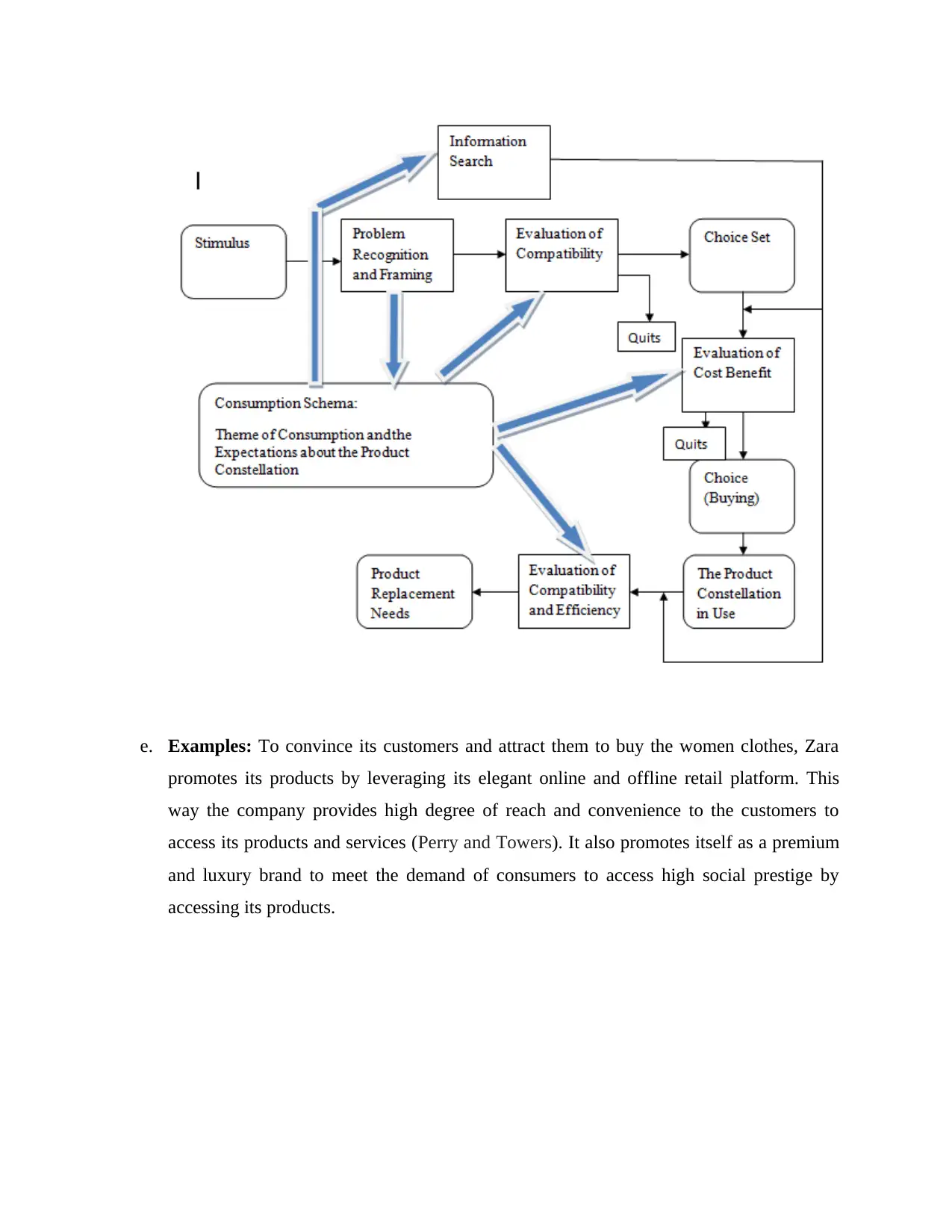
e. Examples: To convince its customers and attract them to buy the women clothes, Zara
promotes its products by leveraging its elegant online and offline retail platform. This
way the company provides high degree of reach and convenience to the customers to
access its products and services (Perry and Towers). It also promotes itself as a premium
and luxury brand to meet the demand of consumers to access high social prestige by
accessing its products.
promotes its products by leveraging its elegant online and offline retail platform. This
way the company provides high degree of reach and convenience to the customers to
access its products and services (Perry and Towers). It also promotes itself as a premium
and luxury brand to meet the demand of consumers to access high social prestige by
accessing its products.
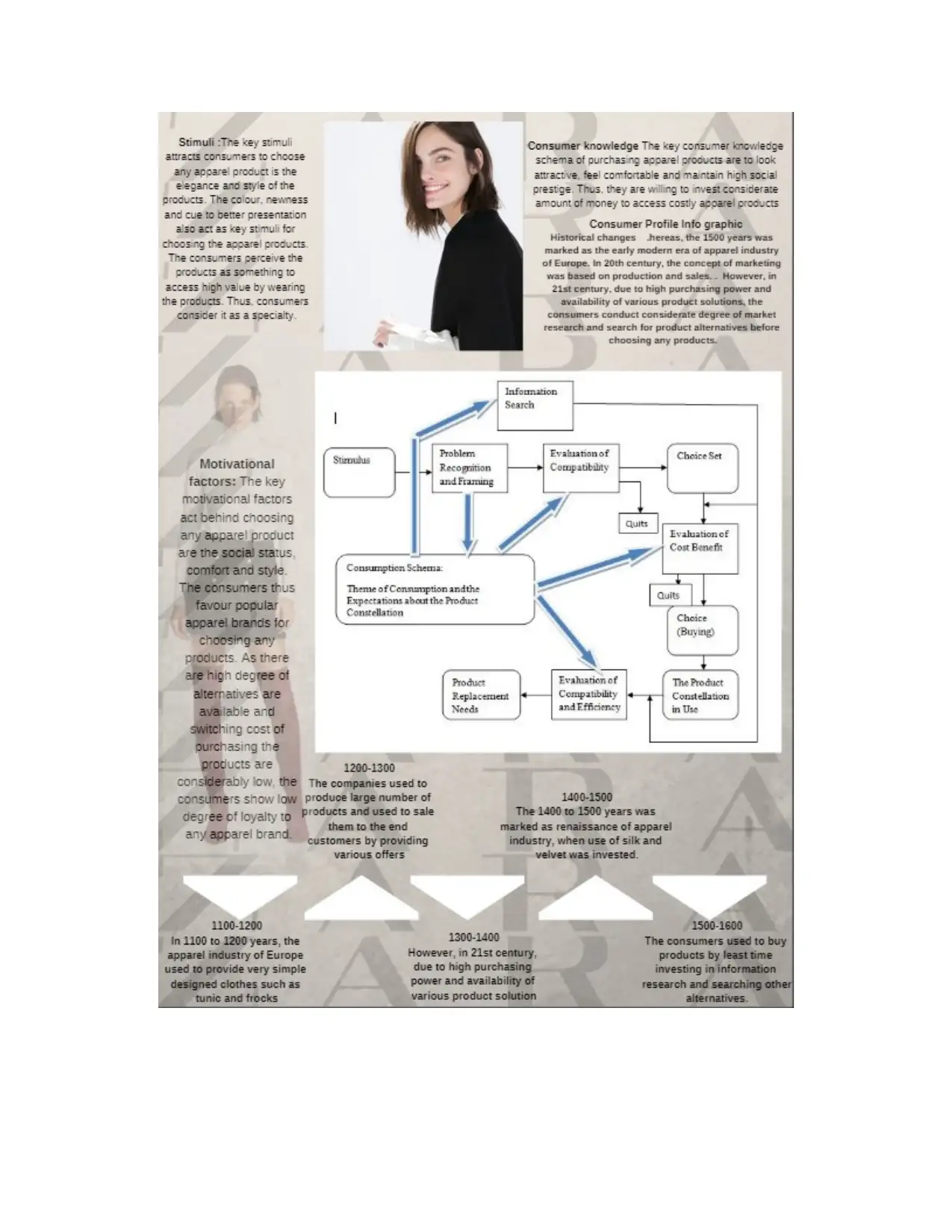
Secure Best Marks with AI Grader
Need help grading? Try our AI Grader for instant feedback on your assignments.
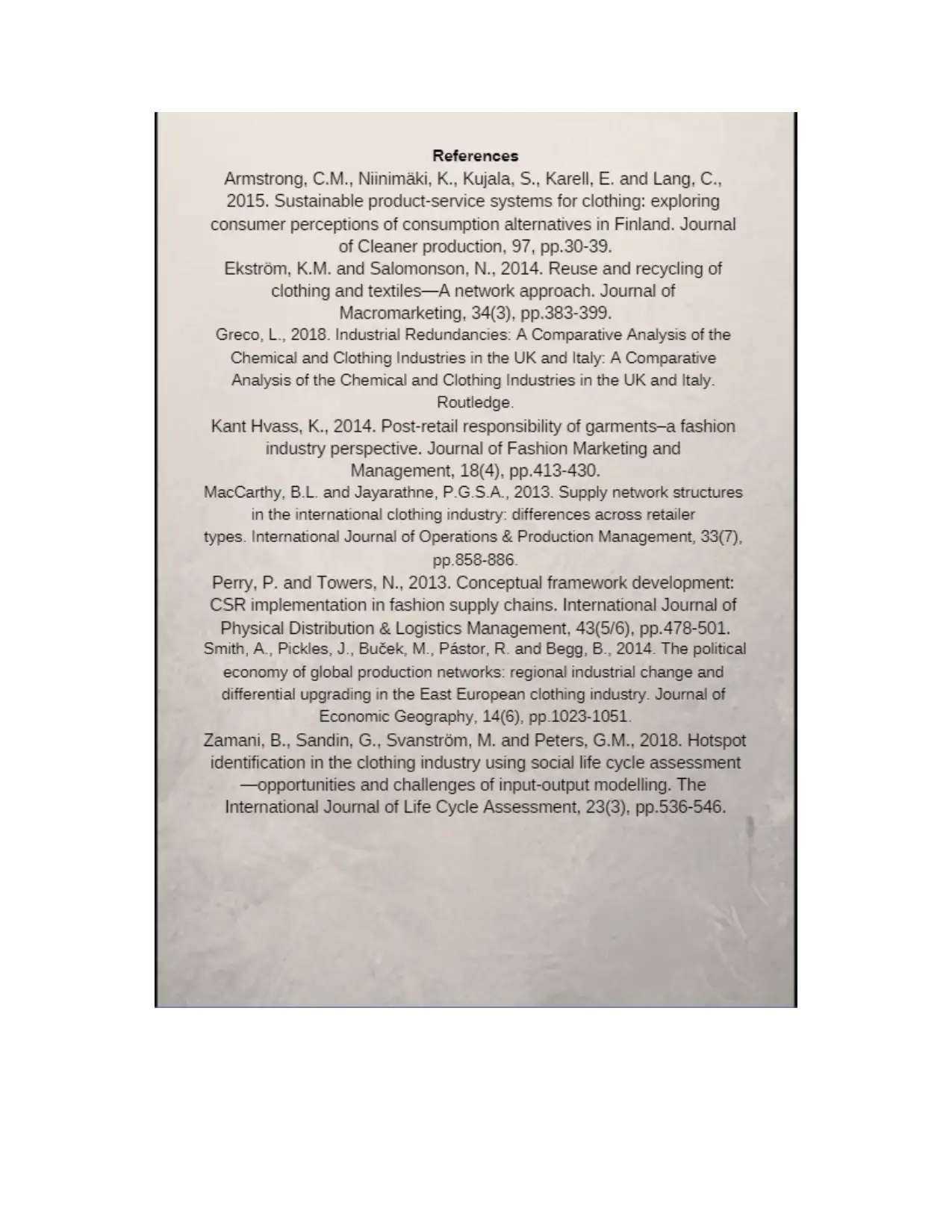
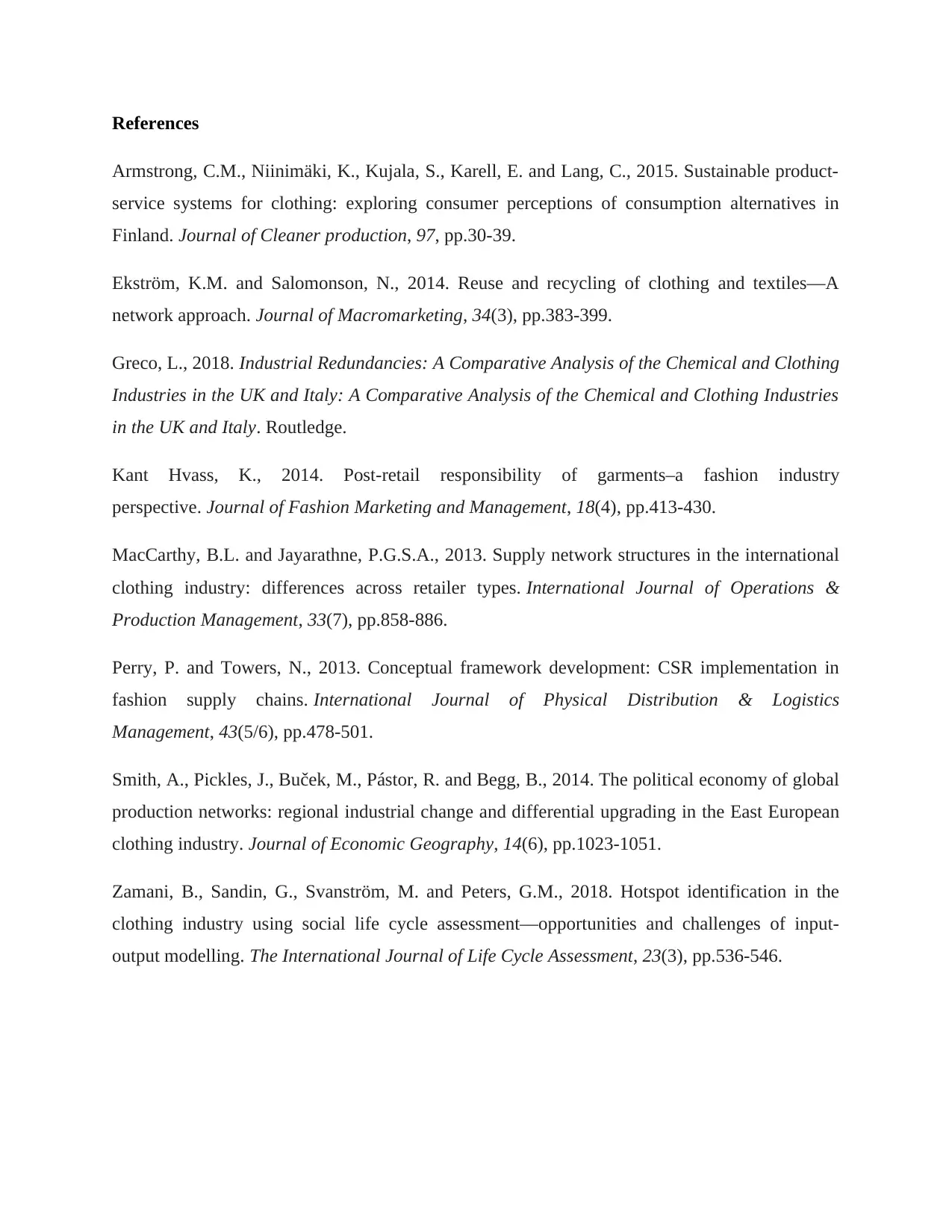
References
Armstrong, C.M., Niinimäki, K., Kujala, S., Karell, E. and Lang, C., 2015. Sustainable product-
service systems for clothing: exploring consumer perceptions of consumption alternatives in
Finland. Journal of Cleaner production, 97, pp.30-39.
Ekström, K.M. and Salomonson, N., 2014. Reuse and recycling of clothing and textiles—A
network approach. Journal of Macromarketing, 34(3), pp.383-399.
Greco, L., 2018. Industrial Redundancies: A Comparative Analysis of the Chemical and Clothing
Industries in the UK and Italy: A Comparative Analysis of the Chemical and Clothing Industries
in the UK and Italy. Routledge.
Kant Hvass, K., 2014. Post-retail responsibility of garments–a fashion industry
perspective. Journal of Fashion Marketing and Management, 18(4), pp.413-430.
MacCarthy, B.L. and Jayarathne, P.G.S.A., 2013. Supply network structures in the international
clothing industry: differences across retailer types. International Journal of Operations &
Production Management, 33(7), pp.858-886.
Perry, P. and Towers, N., 2013. Conceptual framework development: CSR implementation in
fashion supply chains. International Journal of Physical Distribution & Logistics
Management, 43(5/6), pp.478-501.
Smith, A., Pickles, J., Buček, M., Pástor, R. and Begg, B., 2014. The political economy of global
production networks: regional industrial change and differential upgrading in the East European
clothing industry. Journal of Economic Geography, 14(6), pp.1023-1051.
Zamani, B., Sandin, G., Svanström, M. and Peters, G.M., 2018. Hotspot identification in the
clothing industry using social life cycle assessment—opportunities and challenges of input-
output modelling. The International Journal of Life Cycle Assessment, 23(3), pp.536-546.
Armstrong, C.M., Niinimäki, K., Kujala, S., Karell, E. and Lang, C., 2015. Sustainable product-
service systems for clothing: exploring consumer perceptions of consumption alternatives in
Finland. Journal of Cleaner production, 97, pp.30-39.
Ekström, K.M. and Salomonson, N., 2014. Reuse and recycling of clothing and textiles—A
network approach. Journal of Macromarketing, 34(3), pp.383-399.
Greco, L., 2018. Industrial Redundancies: A Comparative Analysis of the Chemical and Clothing
Industries in the UK and Italy: A Comparative Analysis of the Chemical and Clothing Industries
in the UK and Italy. Routledge.
Kant Hvass, K., 2014. Post-retail responsibility of garments–a fashion industry
perspective. Journal of Fashion Marketing and Management, 18(4), pp.413-430.
MacCarthy, B.L. and Jayarathne, P.G.S.A., 2013. Supply network structures in the international
clothing industry: differences across retailer types. International Journal of Operations &
Production Management, 33(7), pp.858-886.
Perry, P. and Towers, N., 2013. Conceptual framework development: CSR implementation in
fashion supply chains. International Journal of Physical Distribution & Logistics
Management, 43(5/6), pp.478-501.
Smith, A., Pickles, J., Buček, M., Pástor, R. and Begg, B., 2014. The political economy of global
production networks: regional industrial change and differential upgrading in the East European
clothing industry. Journal of Economic Geography, 14(6), pp.1023-1051.
Zamani, B., Sandin, G., Svanström, M. and Peters, G.M., 2018. Hotspot identification in the
clothing industry using social life cycle assessment—opportunities and challenges of input-
output modelling. The International Journal of Life Cycle Assessment, 23(3), pp.536-546.
1 out of 6
Your All-in-One AI-Powered Toolkit for Academic Success.
+13062052269
info@desklib.com
Available 24*7 on WhatsApp / Email
![[object Object]](/_next/static/media/star-bottom.7253800d.svg)
Unlock your academic potential
© 2024 | Zucol Services PVT LTD | All rights reserved.